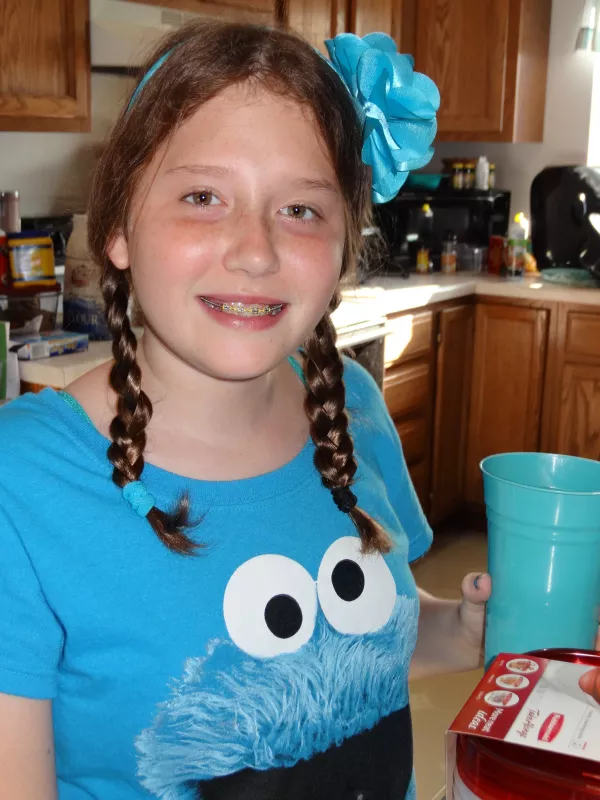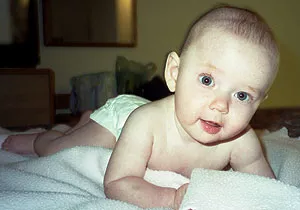Baby with craniofacial defects now a healthy 6th-grader

A mother's intuition leads to second opinion
Margaret Winters credits the internet for directing her family to University of Iowa Stead Family Children’s Hospital and Arnold Menezes, MD, professor of neurosurgery specializing in pediatric neurosurgical procedures and craniofacial surgery. She felt that this would be the answer to her family’s concerns about their new child.

In 2001, Margaret and Michael Winters were living in the Des Moines area with their two sons, Zackary and Jacob, ages 5 and 8. Daughter Mariah was born April 13. A few days later, Margaret started to notice something “just wasn’t right.” The infant had a flat spot above her right eye, making the eye appear larger than the left.
Margaret asked her pediatrician about it at Mariah’s two-week and two-month followup visits and was told that the condition was normal and the baby “would grow out of it.”
Unconvinced, Winters turned to the internet looking for answers, for other parents who had similar concerns, and for doctors who might take her worries more seriously.
It was during a shopping trip that Margaret’s concerns about Mariah’s facial features really came into focus. Standing in a three-way mirror with her daughter, Margaret finally saw what was really bothering her: Mariah’s ears were offset and uneven and her right ear was pushed forward.
Margaret was so concerned she called the clinic immediately and was able to get in the next day, but with a different doctor. At the appointment, the doctor noticed Mariah’s head was asymmetrical. He rattled a toy in front of her and the baby would follow it with her right eye, but not with her left. He diagnosed Mariah with Torticollis, a condition in which the neck is “twisted” and the head is tilted to one side, and ordered physical therapy and an X-ray.
“We went to the hospital for the X-ray and found that Mariah had prematurely fused plates in her skull,” Margaret says. The doctor said the condition was craniosynostosis – a birth defect that causes one or more of the sutures of a baby’s head to close earlier than normal – and referred Mariah to a neurosurgeon.
The family met with the neurosurgeon in Des Moines, but Margaret felt uneasy. Many of the stories she’d read online urged parents to find a neurosurgeon who worked with a plastic surgeon, and this doctor did not.
“I just wasn’t comfortable with the answers he was giving me,” she says.
She found a website that listed neurosurgeons which worked with craniosynostosis and found Arnold Menezes, MD at UI Stead Family Children’s Hospital. She called the Des Moines doctor who ordered the X-ray and explained her concerns, and the doctor arranged an appointment with Dr. Menezes.
“Once we got to Iowa City and talked with Dr. Menezes, we knew we were in the right place,” Margaret says.
Menezes’ evaluation revealed facial and eye abnormalities with abnormal position of the nose and the appearance as though the right eye was more forwardly placed. These abnormalities were confirmed with a 3-dimensional CT scan of the head. The condition was recognized as coronal and basal synostosis with craniofacial dysostosis and exorbitism; in other words, the front half of the right side of the skull had fused prematurely, not allowing for growth of the brain, eye, or face on that side.
Menezes felt that it would be wise to wait until Mariah was five months old so that she could tolerate the procedure well. The craniofacial team at UI Stead Family Children’s Hospital includes board-certified pediatric experts in neurosurgery, plastic surgery, otolaryngology genetics, ophthalmology, and orthodontics. The team performs approximately 50 craniosynostosis operations a year; of those, 20 to 25 are the complex craniofacial reconstruction such as Mariah’s.
On Sept. 18, 2001, Mariah had surgery to correct the abnormality. The surgical procedure lasted 3 to 4 hours and four days later, the family headed home.
When Margaret and Michael brought Mariah back to the hospital four weeks after the operation, all possible concerns were cleared. Mariah showed no sign of vision problems and there were no other issues that sometimes can occur with craniosynostosis.
“We’ve been coming back every two to three years for check-ups,” Margaret says. Although they’re a military family and have moved around, their insurance has let them continue to come to UI Stead Family Children’s Hospital to see Menezes.
Mariah is now a healthy sixth-grader in West Salem, Wis. She has no memory of the surgery but has heard the story and seen the progression of her development in pictures.
“It’s been really weird. The first time Mom told me about it I didn’t know what to think,” she says. “I looked at the pictures and thought I just looked like a normal baby.”
She says she still gets a little nervous each time she comes to the hospital, but even those fears have subsided – Mariah’s last visit with Menezes was in the summer of 2012. At this point, she was 11 years old and Menezes felt that there was no likelihood of any untoward situations that could crop up.
The craniofacial surgical team for pediatric craniofacial dysostosis sees patients on a regular basis after the operation until they are about 8 to 9 years of age. This is because a small number may show up with issues in the neck or in the skull that require attention. This is critical in terms of long-term followup in patients such as Mariah. In addition, ophthalmology and orthodontics are brought into play during early childhood until the child goes into grade school.
Margaret says she’s grateful she was led to UI Stead Family Children’s Hospital.
“I am so glad we were able to find Dr. Menezes,” she says. “I was always happy with the answers he gave me, and he was always very thorough.”
Michael agrees.
“Dr. Menezes did his job wonderfully, but the support staff behind the scenes was just as important, too,” he says. “They really made us feel at home, they were like family.”